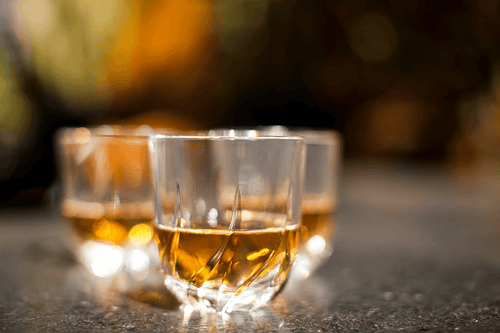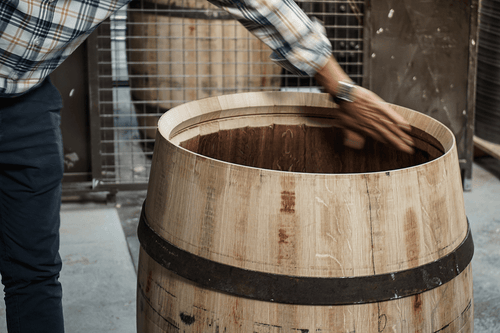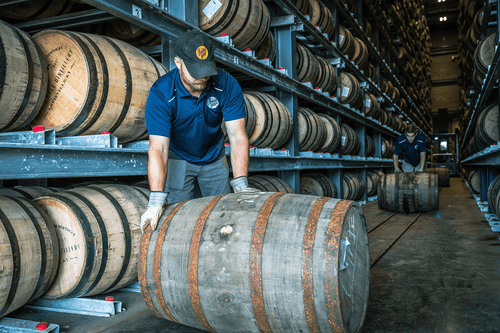How Grains Affect Bourbon Taste
HOW GRAINS AFFECT
BOURBON TASTE
Ingredients are the most important additive to enhance the flavor of any good recipe. The slight change or addition of an ingredient can either throw a recipe off or make it fantastic. This is the same for spirits like bourbon...

To be classified as bourbon, there are basic ingredients that need to be added to whiskey. However, like any good recipe, there's room for alterations. Adding or subtracting grains that make up the mash can drastically alter the bourbon taste.
What Is Bourbon Mash?
Mash is the mixture of ingredients that are combined to create alcohol. A typical mash will include grains, water, and yeast. There are a few requirements that need to be met for a whiskey to be classified as a bourbon. One of these requirements is using corn in the mash. Corn must make up 51% of the mash mixture. A distiller can alter the mash by adding or removing different grains.
The mash is fermented to create alcohol. Distillers must watch their mash carefully to ensure the pH level isn't too high. A high pH level could become a breeding ground for bacteria. One way bourbon distilleries lower their pH levels is by using previous batches of mash, which are more acidic. The process of using some ingredients from a previous batch is called sour mash. Most bourbon is made using the sour mash process.
What Grains Are Found in Bourbon?
Besides corn, other grains can be added to the mash to alter the bourbon's taste. Most whiskeys that are made in North America use four main grains: corn, rye, barley, and wheat.
Why Corn In Bourbon?
Corn helps bourbon taste sweet and provides it with a brown-buttered, honey, and creamy flavor. As an ingredient, corn is sweet, which is why most people find bourbon tastes sweeter than whiskey. Alternatively, whiskey is made primarily with rye or barley, which has a harsher taste. The role of corn in bourbon is to provide cheap carbohydrates that allow the yeast to convert to ethanol, better known as alcohol.
Corn was introduced to whiskey-making in the mid-1700s. After the Revolutionary War, George Washington sought to recoup some of the money lost due to the war. He tried to do this by charging taxes on domestically produced products. Of course, whiskey fell into that category and was hit hardest by these new sanctions.
Distillers disagreed wholeheartedly with this decision. Many of the farmers making whiskey were using their leftover crops to do so. The farmers weren't selling the whiskey but were instead using it to barter. Because of this, there was no additional money to pay for the taxes. This is what started the Whiskey Rebellion.
During the rebellion, many distillers decided to move down south to what is now the Kentucky region. Upon arriving, they found corn in abundance and started using the grain in their mash to enhance the bourbon taste. Centuries later, the U.S. differentiated whiskey made domestically by calling it bourbon. To be classified specifically as bourbon, certain requirements need to be met. One of these requirements is that they must make the mash of 51% corn.
Why Barley In Bourbon?
There are two types of barley used in bourbon: malted and unmalted. Malted barley is a process performed to help the barley produce enzymes. These enzymes create long-chain carbohydrates which eventually turn into alcohol. Malted barley can help bourbon taste nutty, smoky, and chocolaty.
Unmalted barley, by comparison, holds the same amount of starches as the malted version but doesn't go through the steeping and germination process. Therefore, unmalted barley has a very different taste. Most unmalted barley will have a fruity or sour taste similar to green apples or lemons. Most scotch distilleries prefer to use barley as the main ingredient for its smoky-earthen flavor.
Why Rye In Bourbon?
Many settlers who came to America chose rye over barley for their bourbon. Rye can grow almost anywhere, but barley requires a specific environment to survive. Distillers use rye because it helps the bourbon taste spicy. This spicy flavoring is similar to black pepper, anise, mint, or rye bread. Rye also enhances the clove and nutmeg flavors that bourbon extracts from oak wood barrels. A rye whiskey needs to have certain requirements to be labeled as such. Rye whiskeys have 51% rye instead of corn.
Why Wheat In Bourbon?
Most whiskey distilleries don't use wheat in their spirits. However, some bourbon distilleries use wheat in their mash to help mellow the taste. The grain itself doesn't have much flavor, but it can have a bread-like taste to it.
Other Nontraditional Grains In Bourbon
Many distilleries are experimenting with different grains to enhance their bourbon taste. Some of the new grains integrated into bourbon are brown rice, quinoa, oatmeal, and triticale. Brown rice pairs nicely with the oak and vanilla flavors found in a typical bourbon. The grain provides an altered, toasty flavor, which sets it apart from traditional bourbon.
Quinoa is high in protein and has become a mainstream grain used by chefs globally, so it's no surprise it's found its way into bourbon. This grain adds a nutty earthiness to the liquor's flavor.
Oats, a breakfast favorite, have also found their way into bourbon. Piggy-backing on the oatmeal stout trend in the brewery industry, bourbon distilleries are integrating oat grain into their mash. Oats don't have an acute taste but act as a flavor balancer, enhancing a bourbon's taste by mellowing out the earthiness of barley and the harshness of rye.
Don't worry if you haven't heard of triticale, this grain is a hybrid grain. Wheat and rye are combined to produce the best of both grains: the high-yield potential of wheat and the hardiness of rye. Triticale can produce a softer bourbon taste.
Next time you try a bourbon, take a sip to see if you can taste some of the flavors of these different grains. You can even take your bourbon with ice, a drop of water, or straight to try it in a variety of ways and discover what suits your palate.






















